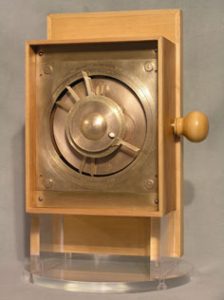Here’s a gorgeous video featuring a mechanical model of the solar system, attributed to the famed Greek inventor Archimedes and now reconstructed by the London-based mechanician Michael Wright. This globe, made from copper and brass (although the original would have been bronze) displays the movements of the Sun, Moon and planets as they travel through the night sky.
The model is being displayed for the first time from 27 September at the Basel Museum of Ancient Art in Switzerland, and I’ve written a news story about it for this week’s Nature.

Wright, previously a curator at the Science Museum in London, has spent many years studying the Antikythera mechanism, a complex geared device found on a 1st-century-BC shipwreck, and was the first to build a working model of it. Now he has turned his attention to Archimedes’ sphere, which dates from about 200 years earlier. No physical trace of this instrument survives today, but Wright believes there are enough clues in ancient descriptions, for example by the Roman author Cicero, to attempt a reconstruction.
In his work De Re Publica, Cicero said that the globe showed the Sun, Moon and five known planets, and that the mathematician Archimedes “had thought out a way to represent accurately by a single device for turning the globe those various and divergent movements with their different rates of speed”. When the globe was moved, he said, “the moon was always as many revolutions behind the sun on the bronze contrivance as would agree with the number of days it was behind it in the sky”.
Wright’s version of the globe has 24 gearwheels inside, and is built using similar techniques to those found inside the Antikythera mechanism. The later device also shows the movements of celestial bodies, but on a flat dial rather than a 3-dimensional globe.
To make sense of Archimedes’ sphere, imagine the Earth as a tiny ball in its centre. The visible part of the globe represents the night sky, and it has star constellations engraved on it. As the globe is moved by hand (to simulate the stars moving through the sky), the gearing inside drives the pointers backwards and forwards, so that their tips show the positions of the planets.

Wright emphasizes that we can’t know for sure that Archimedes built his globe in exactly this way, but says he wanted to prove that such a device is at least possible. “It’s meant to make other people wake up and think,” he says. The reconstruction is also a useful reminder that the Antikythera mechanism was not the only geared device around in antiquity. “There was a busier industry of small mechanical work that most of our perception of ancient history would lead us to believe,” says Wright.
Such devices are fascinating in themselves, but they also provide an intriguing glimpse into the Greek psyche at a time when scholars were struggling to understand how the solar system works, according to Mike Edmunds, emeritus professor of astrophysics at Cardiff University.
We often think of science as relatively modern development, but Edmunds disagrees. The point of geared astronomical models, he says, was to show that even the most irregular motions in the cosmos could be driven by a single machine. “If you can show it can be done, without requiring gods to push round the balls, you are already some way towards a proper scientific explanation.”

I wonder if the sphere of archimedes and/or the antikythera mechanism were able to show the retrograde movements of the planets.
Thanks for the article and kind regards
Hi Eduardo – yes, both devices were able to show the retrograde motions of the planets – the planetary gearing of the Antikythera mechanism is lost, but researchers conclude from its inscriptions that this was almost certainly achieved using epicyclic gearing (gear wheels riding around on other wheels).